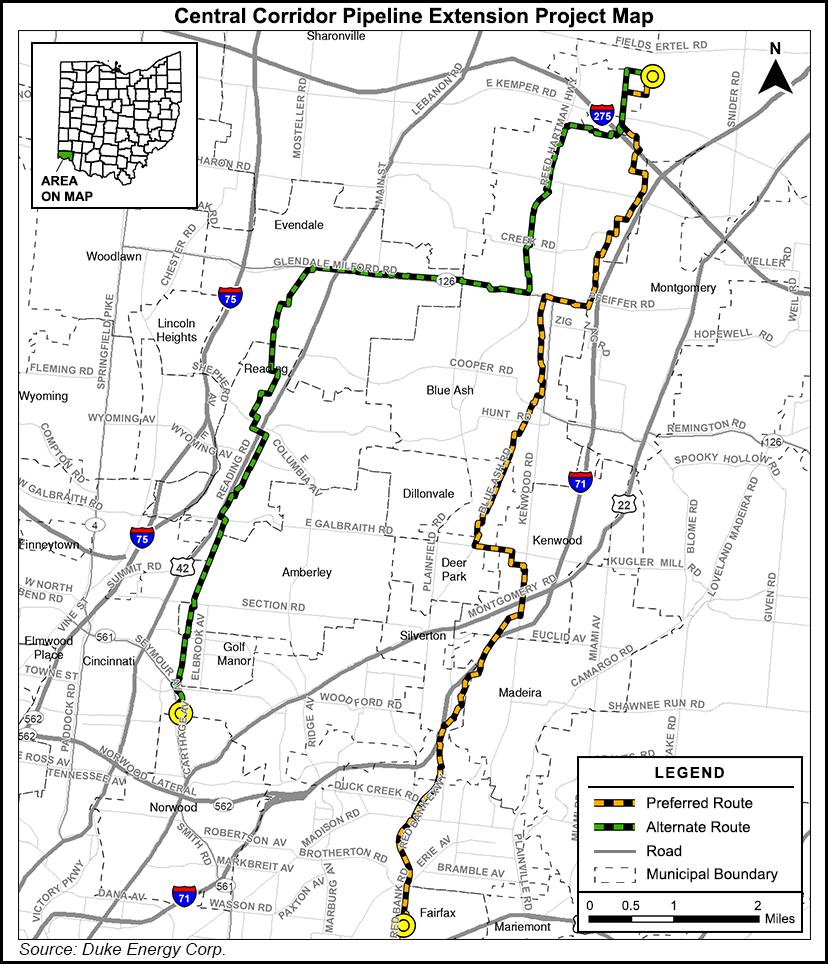NGI The Weekly Gas Market Report | Infrastructure | NGI All News Access
Duke Scales Back Plans for NatGas Pipeline in Southwest Ohio
Duke Energy Corp. said that in response to feedback from the community, it has modified plans for its Central Corridor Pipeline Extension Project in southwest Ohio, and is now proposing a smaller natural gas pipeline that would operate under lower pressure.

Officials said Tuesday the project would now call for constructing a 20-inch diameter steel gas pipeline, which would operate at 400 psi and have a maximum capacity of 168 MMcf/d. By comparison, the project originally called for a 30-inch diameter pipeline operating at about 600 psi with a maximum capacity of 240 MMcf/d.
“We have been listening to feedback from our customers, neighbors and community leaders,” said Jim Henning, president of Duke Energy Ohio and Kentucky. “The reduction in size and pressure of the proposed natural gas pipeline is a direct result of this feedback. This new pipeline is critical for us to continue safely meeting the natural gas needs of nearly two million people in this region, both today and for generations to come.”
The modified plan was submitted to the Ohio Power Siting Board (OPSB) for its approval. Duke also submitted two proposed pipeline routes for the regulatory agency to consider. The new pipeline would originate at an existing gas transmission line near the intersection of Ohio’s Butler, Hamilton and Warren counties. It then would traverse close to 12 miles of central Hamilton County and the northern parts of Cincinnati, terminating near the city of Norwood or the Village of Fairfax.
The company said its preference is for the pipeline to follow the eastern route, which would terminate in Fairfax, but OPSB is to make the final decision. The project is estimated to cost $100-150 million, depending on which route is ultimately selected.
Last June, the Cincinnati City Council passed a resolution opposing the project and adopted a pair of motions to try and circumvent it (see Daily GPI, June 16). The scaled back plans did not appear to mollify many of the project’s opponents, including the Neighbors Opposing Pipeline Extension (NOPE).
“While this appears to be a reduction in size and pressure from Duke’s original proposal, NOPE is still evaluating whether the new plan addresses the community’s safety, environmental and economic concerns,” it told the Cincinnati Enquirer. “We’ll need to investigate further before deciding what further action is necessary.”
A spokeswoman with the Hamilton County Board of Commissioners confirmed to NGI that the board voted 3-0 on Wednesday to file for intervenor status with the OPSB over the pipeline.
Construction is expected to begin in summer 2017 and be completed by fall 2018. The project is a result of a 2015 study conducted by Duke its high-pressure steel pipelines, some of which were built in the 1950s.
© 2024 Natural Gas Intelligence. All rights reserved.
ISSN © 1532-1231 | ISSN © 2577-9877 | ISSN © 1532-1266 |
